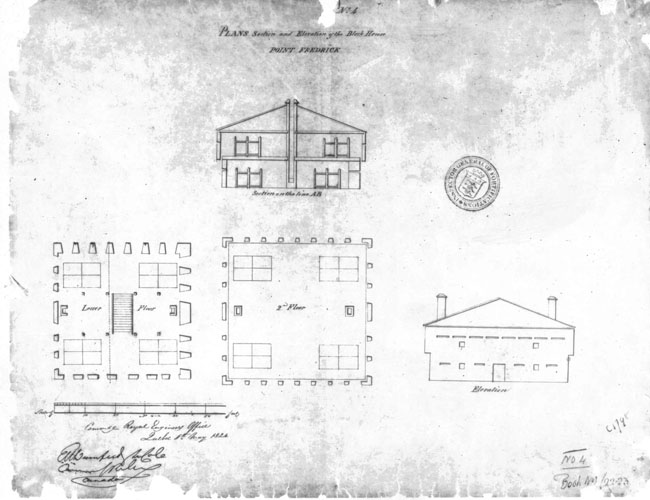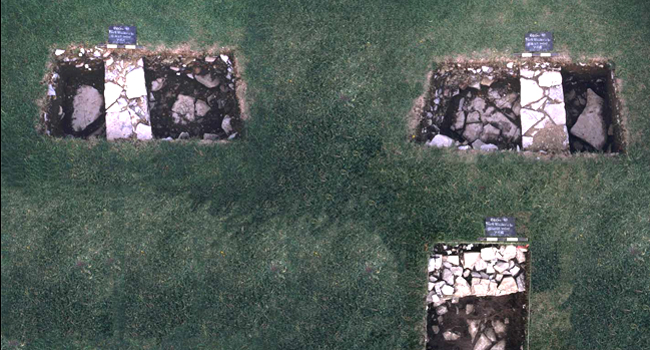Named after General Sir Frederick Haldimand, who was Governor of Canada from 1777-86, Point Frederick is located at the junction of Lake Ontario, the St. Lawrence River and the Great Cataraqui River. A recognized strategic location by the French, the British and the Americans, it is not surprising that it was eventually established as the British Naval Dockyard, and a fort to protect it.
With the establishment of the Dockyard in 1789 a need for the defence of Point Frederick quickly became a concern. During the early years of the dockyard, several vessels were constructed. These activities, in conjunction with the established buildings at Point Frederick effectively made it the headquarters of the Navy on Lake Ontario. But it would not be till the War of 1812, that a Fort would be built on the point.
Prior to the outbreak of war in 1812, the town of Kingston and its harbour had only a garrison of a 100 men of the Veteran Battalion and a local militia of Loyalist veterans to defend it. With the formalization of the position of the dockyard at Kingston during the War of 1812, the dockyard now served as the British naval base for the Great Lakes fleet, and therefore needed decent defences. The construction of a Battery at Point Frederick was delayed by subsequent changes to the military jurisdiction over the Point; in 1806 the Quartermaster General’s Department assumed full control of the military establishment at Point Frederick and things began to happen. With the outbreak of war in 1812 a Battery was established at the tip of Point Frederick to provide support for the construction of buildings and the Dock Yard. A formal blockhouse structure of a good size, 45’ by 45’, was built along with supporting buildings and the Battery for 6 and 9 pounder guns. The Fort was in extensive use throughout the war and took part in the exchange with an American Squadron on 12 November 1812. Work continued on the Blockhouse at least into the spring of 1813, this blockhouse would serve as the main defence point around which a series of buildings were constructed to service the Fort and provide protection for the dockyards and Kingston harbour. The Blockhouse lies in the approximate location of the Fort Frederick Tower constructed in 1846 as part of the new Fort that is preserved today.

The Fort was in extensive use throughout the war and took part in the exchange with an American Squadron on November 12, 1812. Following the signing of the Treaty of Ghent the Fort went into a phase of lesser use and manning, and eventual decline, only receiving a reprieve with the rest of Point Frederick during the crisis of 1837. Many of the Fort buildings were in a terrible state of repair and likely abandoned before the new Martello Tower and earthworks of Fort Frederick were constructed in 1846. With the construction of the new Martello Tower, the remaining standing buildings of the War of 1812 Fort were demolished, often pushed in on themselves. The Blockhouse was filled with the debris of the building, likely minus what could be salvaged, and the foundation was additionally filled with limestone debris from the construction of the Martello Tower. The entire parade grounds surrounding the Tower were resurfaced, primarily with a pavé, as part of the work to “landscape” the Fort and construct the defensive earthworks. According to the 1824 Board of Ordnance Map there were 9 buildings extant within the Fort grounds. These included Royal Artillery Barracks, a Guardhouse, a Magazine, Latrines, a Well, a Canteen, an Armourers’ Shop, Officers’ Quarters, and Barracks. No buildings survive above ground from the dockyard period with the exceptions of the Gatehouse, Warders Lodge, a section of seawall, parts of the Commandant’s House and the later Stone Frigate.
In the modern history of Point Frederick the Fort was subject to organized trenching by the RMC museum curator Pip Nation and a group of summer students. The Blockhouse and the Privy were dug. The Blockhouse was subject to trenching adjacent to the walls and cement capping on all surviving walls. These “excavations” took place in 1969, and information on these diggings is sparse at best. Thus the planned excavation for the “Can You Dig It?” © program provided an opportunity to assess the damage caused by these previous efforts.
The “Can You Dig It?”© summer program was conducted at Fort Frederick between 2003 to 2005. After three seasons of fieldwork at the site of Fort Frederick, it has been possible to archaeologically examine several areas of the War of 1812 period fort and the 1846 tower. It is clear that although no abundant physical structures remain from the War of 1812 period, that there are undisturbed cultural deposits and building foundations at the site. There are also intact deposits relating to the construction and occupation of the 1846 Martello Tower and its associated structures. The majority of the material culture was recovered from the Tower period latrine, the area between the War of 1812 period canteen and guardhouse, with smaller amounts from other areas. Much of the material from the latrines was determined to date to the early College period. Small amounts from other locations appear to be of an earlier date including the War of 1812 period and subsequent Tower period.




